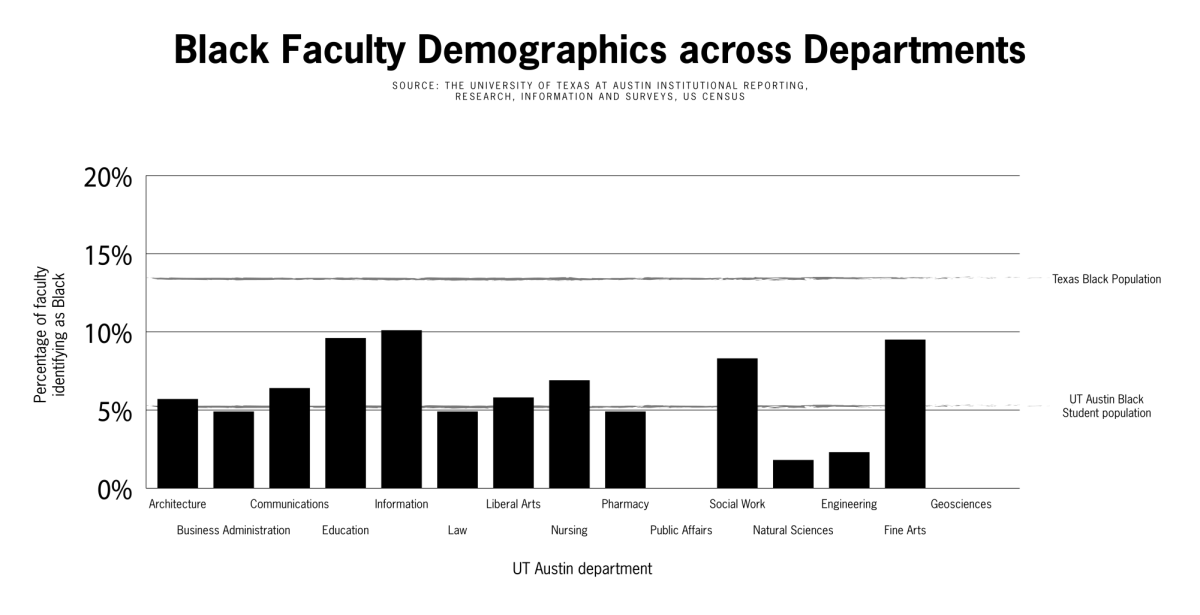The Cockrell School of Engineering marks Sept. 1, 1964 as an important day in helping “pave the way for continued desegregation across the University.” This date marks when Ervin Perry became an assistant professor of civil engineering and consequently the first Black faculty member at UT.
Since then, the University has made efforts to recognize and reckon their history with faculty diversity, such as creating college-specific diversity officers and the Division of Diversity and Community Engagement. Even in light of anti-DEI bills passed by the Texas legislature, UT has attempted to maintain these inclusion efforts.
However, as of Fall 2022, Black faculty made up only 5.3% of the total faculty at UT.
While UT has low Black faculty representation, especially as a university in the state with the nation’s highest Black population, this statistic would still likely score UT an A in faculty hiring, according to a report released by The Education Trust, an education advocacy group.
On average, Black faculty make up only 4.3% of faculty populations at higher education institutions, and Black professors across the nation have repeatedly cited concerns about the lack of university representation.
Determining faculty diversity is commonly based on how closely professor demographics mirror student demographics, and with UT having 5.3% of faculty identifying as Black, the demographics seem to match its student body. However, distribution of Black faculty is heavily skewed across departments based on the 2022 data. Within the College of Fine Arts, the percentage of Black faculty sits at a high 9.5%. While the total number of faculty in the Jackson School of Geosciences and the LBJ School of Public Affairs sits only around 60 members, 0% of faculty identified as Black, meaning there are less than 5 Black faculty members in each college.
“The Jackson School of Geosciences works very hard to recruit the most talented students, faculty, staff and research scientists from all backgrounds and perspectives, while following all applicable laws,” said a media representative for the School of Geosciences. Samaria Taylor, president of The Black Studies Experience student organization, said she was disappointed to see the statistics on faculty demographics.
“Representation in the field that you want to go into is encouraging,” said Taylor, a government and African & African diaspora studies sophomore. “To not have that … I wouldn’t feel inspired to do more than what I’m doing; to do more than what I came here for. … Connections help you get so far. … It’s easier to build that connection when y’all are both Black.”
During the summer of 2020, President Hartzell announced steps to promote diversity and equity and to recruit, retain and support more Black students, faculty and staff on campus. The number of Black faculty members has steadily increased, but progress remains slow. From 2009 to 2022, UT’s Black faculty has grown from 3.4% to 5.1%, meaning there’s been a 1.7% increase in 13 years.
For the last 20 years, associate government professor Eric McDaniel has taught students on UT’s campus, and he claims his time has overall been a positive experience. However, as one of the few Black faculty, he’s aware of this lack of representation, and claims the issue starts with the lack of Black students.
“It’s expected; UT is no different from other major universities,” McDaniel said. “I think it’s been an issue of graduate programs producing Black scholars. In my 20 years here, at most two Black students have finished the Ph.D. program … so we’ve had a hard time getting them here and then a hard time getting them through.”
In 2013, only 2.9% of graduate students identified as Black, and, as of 2022, not much has changed. The demographic is still one of the smallest, and there’s been only a 0.6% increase since then.
The lack of representation doesn’t just affect graduate students. Evan Craig, co-president of the Black Studies Experience, said he wishes that UT could support Black students with more on-campus resources.
“I would love for them to possibly find a way to try and give more opportunities for Black university students, and that could be simply just from scholarships, mental health resources … and also just guiding them … to help them find connections,” Craig said.
With recent DEI changes that have hurt professors’ outlook on staying in Texas, McDaniel said UT has faced difficulties hiring faculty to come to Texas. He said he predicts the number of Black faculty at UT will inevitably decline and become less representative of the student population.
“I do expect there to be a dwindling number of faculty of color,” McDaniel said. “With the state doing things like (anti-DEI legislation), it sends a message that you’re not welcome here. Even if they make an offer to a person of color, (UT) is gonna have to work a little bit harder to get them here.”
University spokesperson Brian Davis said UT saw almost a 30% increase in applicants for faculty, staff and administrative positions over the previous year. With 90,150 job applicants in the 2021-2022 fiscal year compared to 115,654 applicants in the 2022-2023 fiscal year.
McDaniel, however, said he remains unconvinced the increased application count is indicative of stronger diversity. Based on his experience, he said he’s worried that without university intervention, Black scholars will run into the same challenges he’s faced as being one of the few in academia.
“(It’s hard) being isolated, having to deal with questions about (if) you really belong here,” McDaniel said.















